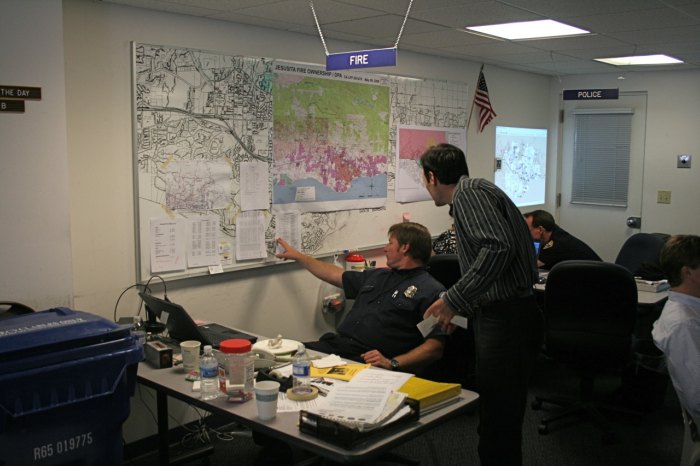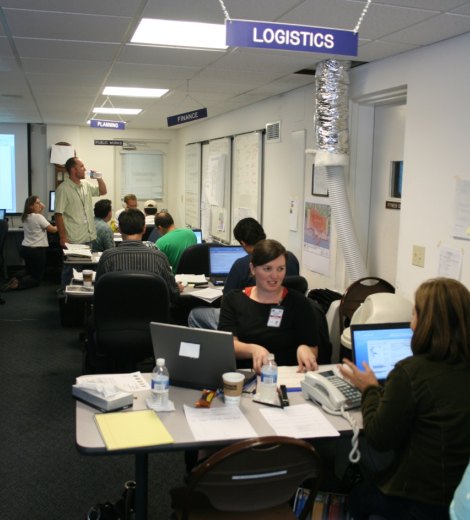The Behind-the-Scenes Machine
A Look Inside the City of Santa Barbara's Emergency Operations Center

Earlier today, as the Jesusita Fire became more controlled and contained, members of the media were allowed a glimpse into the nerve center of the City of Santa Barbara’s Emergency Operations Center (EOC). Organized and set up as a way to centrally manage and mitigate emergency situations, the center – which is located downtown within the Figueroa Street police station – is staffed by regular city employees who have been specifically trained to work for the EOC during times of crisis. Simply put, the EOC makes it all happen – it is the unseen machine that, through the support and coordination of Field and Department Operations Centers, ensures the city and its various departments are able to quickly and effectively respond to large-scale emergencies.

After being greeted on the front steps of the police station by Mayor Marty Blum, Police Chief Cam Sanchez, Councilmember Grant House, and a handful of high-ranking city employees including Community Development Director Paul Casey and City Administrator Jim Armstrong, the small media contingent headed down to the basement of the police station to see firsthand how the 24-hour EOC operates during a typical day of disaster mitigation.
On the way, Sanchez noted that EOC staffers “are unsung heroes” and that their efforts go largely unreported since they are essentially “behind the scenes.” But, Sanchez went on, their work is nevertheless crucial for those fighting on the front lines – they are an indispensable “bloodline” of communication and management. Working in 12-hour shifts, the temporary EOC employees are both expected and willing to go above and beyond their usual job descriptions and, when called upon, assist in management and coordination functions; they are chosen based on the experience and skills accumulated during their non-disaster day jobs. The center is staffed with about 125 individuals – with about four people trained for each specific role – and is headed by full-time Emergency Services Manager Yolanda McGlinchey. In preparation for future disaster abatement, each staffer goes through a rigorous training progress including mock emergencies and table-top exercises, all in order to ensure that the EOC operates as efficiently and seamlessly as possible when it is needed.
Upon entering the center, one is struck by an intense yet focused hum of activity – phones ring constantly, maps and message boards are marked and updated, TVs flash news broadcasts, and all the while, staffers (about 25 of them at the time) either type rapidly on their laptops or mill about the small room, speaking with members of the various represented departments. The center itself is separated into distinct divisions, each with a specific purpose and objective, but all adhering to the overarching guidelines of the National Incident Management System that provides a streamlined and standardized method of organization for the EOC. Speaking with each department and its representatives, the extent and meaning behind the delegated responsibility became clear.

The logistics team summed up their job description with the concise quote: “When people need things, we get them. We make sure it happens.” Charged with taking all kinds of requests – from gas for generators, to maps for officers and firefighters, to chairs for shelters – the logistics department ensures that emergency workers in the field are never in want of necessities. They take dozens of calls and emails a day from city staff, public works officers, and police and firefighters, and, after logging the needs on official “Logistics Service Requests” forms, follow up to make sure items get where they were supposed to go. The department also keeps track of all donations provided by companies and restaurants in order to send out acknowledged appreciations for such contributions. At the time, Logistics was staffed by Parks and Recreation Director Nancy Rapp as well as Library Director Irene Macias.

At the Liaison station, three Red Cross representatives, headed by Santa Barbara Chapter “mentor” Sharon Eames, explained that they are charged with keeping the city updated on shelter needs, statuses, and numbers. In constant communication with the logistics and planning divisions, the three Red Crossers, two of whom had recently arrived from the Santa Cruz chapter, expressed how impressed they were with the turnout of volunteers at shelters throughout the city. They also noted that, in light of the recurrent and inevitable emergency situations in the area, the Red Cross has been especially dedicated and diligent in training those who hope to help with the care and housing of displaced residents.
Next, at the Finance division, Assistant Finance Director Bob Samario stated that he is responsible for making sure that any and all expenses related to emergency relief – including equipment usage, patrol vehicles, and aircraft – are properly documented. In order for Santa Barbara to be reimbursed for the operating cost of fighting the Jesusita Fire, Samario explained, all EOC employees (and indeed anyone involved in the fiscal aspect of the effort) must fill out specific paperwork, coding and denoting expenses in an accepted and standardized way. Samario went on to say that he expects 93 percent of Santa Barbara’s expenses to be reimbursed by the state and federal governments once the federal government officially declares the Jesusita Fire situation an emergency.
The Planning and Intelligence team, headed by Housing and Redevelopment Director Brian Bosse, appears to possess some of the center’s most important and challenging responsibilities. Its primary objective, Bosse explained, is to both collect from and distribute information to the various EOC divisions. Its staffers are also charged with maintaining an electronic status report that is projected on a large screen for all within the EOC to see. Additionally, the Planning and Intelligence crew is charged with generating the large, accurate, up-to-date maps that are plastered throughout the EOC; these maps provide crucial information not only for the public, but also for police and fire crews out in the field. The team also creates phone and contact lists for all EOC employees for quick and easy internal communication between departments.
At the police division, Lieutenant Paul McCaffrey explained that it is his responsibility to help coordinate with officers in the field, setting priorities and assessing the various police-related dynamics of the emergency situation. In constant communication with the Fire Department, McCaffrey and other police EOC workers ensure that people are able to safely evacuate when the need arises, as well as provide assistance and direction to outside firefighters who are not familiar with the area. Additionally, the division helps maintain checkpoints and prevents any looting or burglaries within evacuated neighborhoods. In short, said McCaffrey, “[The police] are a support role for the fire mission.”

The fire division, at the time of the tour, is manned by firefighter Matthew Gritt, who admitted that his position was typically staffed by a higher-ranking officer within the Fire Department. However, Gritt was able to give an overview of his department’s job description within the EOC. Fire, he said, is essentially a go-between for all the departments, absorbing and disseminating critical information. Gritt also explained the necessity and importance of the mutual aid system that is responsible for recruiting fire crews throughout the state when assistance is needed. The fire division also works in tandem with the Public Works department to ensure that water is always available to firefighters in the field.
The public works section, staffed by Facilities and Energy Manager Jim Dewey, coordinates all things street and water – the department makes sure firefighters have access to adequate water sources by tracking reservoir levels, water pressure, and hydrant function. They also, said Dewey, coordinate and provide street barriers to ensure that evacuated areas are clearly designated and maintained.
Each section of the EOC, working toward the common goal of city-wide emergency management, commended their fellow city employees who had transcended the responsibilities of their day jobs and contribute to the widespread effort. Santa Barbara residents, they said, should take comfort in knowing that such a well-organized concentration of information flow exists, and that the whole enterprise is able to be up and running in about 45 minutes, should the need arise.



